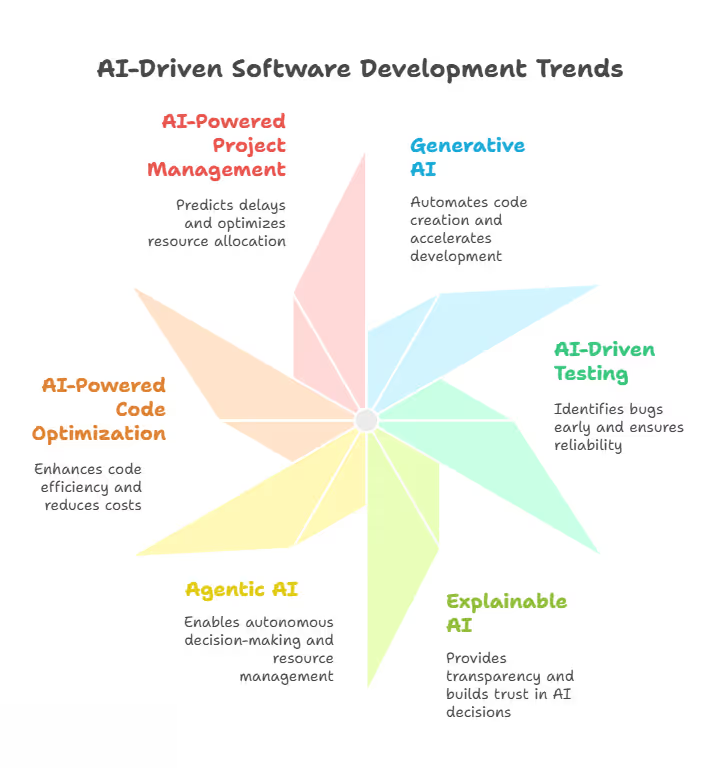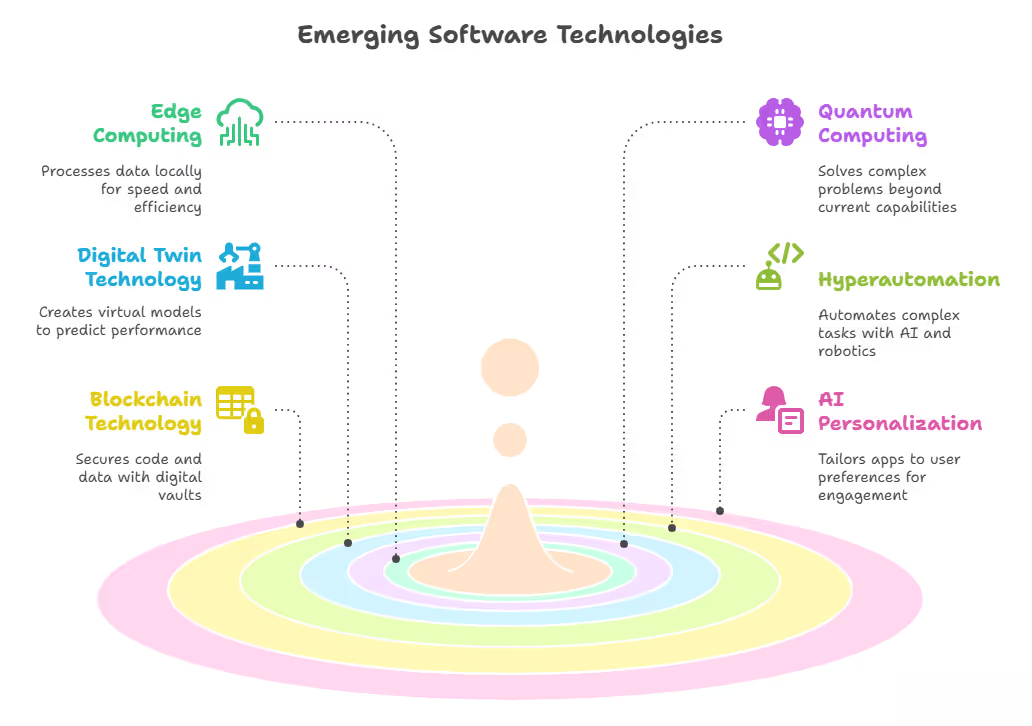Future of Software Development in Next 10 Years

The future of software development in the next 10 years will be defined by AI-driven coding, low-code platforms, cloud-native applications, stronger cybersecurity, and the rise of quantum computing.
For U.S. businesses, this means faster product cycles, smarter automation, and development models that blend human creativity with machine efficiency.
AI Is Changing How Software Gets Built. Are You Ready?
From agent-driven automation to no-code tools, the software development landscape is evolving fast.
Find out what this shift means for your business today — and how to prepare your team for the next decade.
✅ Get our free strategy brief: ‘AI Agents & the Future of Dev Teams’
AI-Driven Software Development Trends
AI isn’t just a buzzword, it’s reshaping how I code, test, and manage projects.
These AI-driven software development trends are the backbone of future software development.

Generative AI: My Shortcut to Faster Coding
Generative AI has been a lifesaver in my projects, churning out code faster than I ever could. It’s like having a coding buddy who never sleeps, making it a cornerstone of software developer trends 2025.
- What It Does: Tools like GitHub Copilot suggest code snippets, fix bugs, and even write full functions based on my project’s context. “Generative AI can accelerate coding by automating repetitive tasks,” says McKinsey, estimating a 20-45% productivity boost.
- My Experience: While building a payment gateway for a retail client, generative AI auto-generated secure API calls, saving me two days of work. It felt like cheating, but the results were rock-solid.
- Enterprise Value: For CTOs, this means shipping apps faster without burning out your team. It’s perfect for tight deadlines in industries like fintech.
- Scalability: Pairs beautifully with cloud-native development for seamless scaling.
- Challenges: It’s not perfect, sometimes AI suggests quirky code that needs tweaking. I always double-check for edge cases.
- Action: Try AI coding assistants for repetitive tasks like form validation or API integration. It’s a game-changer for future software development.
Agentic AI: Autonomous Coding That Surprised Me
Agentic AI feels like sci-fi, it’s AI that makes decisions on its own, and it’s blowing my mind as part of software developer trends 2025.
- Functionality: It adapts to new situations, like rerouting cloud resources during a traffic spike. MIT Technology Review says it could “redefine workflows by 2030".
- My Story: I used agentic AI in a DevOps pipeline to manage server loads during a Black Friday sale. It cut downtime by 25% without me lifting a finger.
- Benefits: Saves time and boosts efficiency in fast-paced sectors like e-commerce.
- Enterprise Use: Perfect for automating complex tasks in large-scale projects.
- Challenges: Requires careful monitoring to avoid unexpected decisions.
- Action: Pilot agentic AI for tasks like resource allocation in cloud-native setups.
Wondering What AI Agents Can Actually Do for Your Dev Team?
Our AI-powered development agents help teams accelerate delivery, automate QA, integrate faster, and reduce technical debt, with real results, today.
✅Book a free consultation to see how agentic workflows can augment your current stack.
Cloud-Native Development: Scaling My Projects with Ease
Cloud-native development lets my apps scale like a dream, a core part of AI-driven software development trends.
It’s how I keep projects running smoothly under heavy loads.
Why Cloud-Native Powers Future Software Development
Cloud-native apps use microservices and containers to handle growth.
It’s the future of scalable future software development.
- Functionality: Tools like Docker and Kubernetes keep apps running during traffic spikes. CNCF says 90% of companies are exploring cloud-native tech.
- My Story: I built a cloud-native e-commerce app that handled a million users during a sale without crashing.
- Benefits: Ensures uptime for streaming or retail apps.
- Challenges: Requires expertise to set up, but the payoff is huge.
- Action: Adopt Kubernetes for apps that need to scale fast.
- Future Role: Central to future of software development in next 10 years.
DevSecOps: Securing My AI-Driven Projects
DevSecOps bakes security into every step, critical for trending technologies in software development.
It’s how I keep my cloud apps safe from cyber threats.
- Why It’s Needed: Cloud apps face growing risks. IDC predicts 60% will adopt DevSecOps by 202.
- My Experience: I used DevSecOps to scan a cloud app, catching a vulnerability before launch.
- Benefits: Protects data and builds trust in industries like finance.
- Implementation: Tools like Snyk integrate security into CI/CD pipelines.
- Action: Add DevSecOps to your cloud-native workflows.
- Future Impact: Essential for secure future software development.
AI Trust and Security Management: Protecting My Code
AI trust and security management uses AI to keep my systems safe, aligning with emerging software technologies.
It’s like a digital bodyguard for my apps.
- How It Works: AI monitors for threats, like unusual activity in a cloud app. A 2024 report says AI security cuts risks by 20%.
- My Story: I used AI security on a banking app, catching a potential breach early.
- Benefits: Ensures compliance in regulated sectors like healthcare.
- Challenges: Requires setup time to calibrate AI correctly.
- Action: Use AI security tools for cloud-native apps.
- Long-Term Value: Key for secure future of software development in next 10 years.
Emerging Software Technologies: What’s Next in My Coding World
Emerging software technologies are pushing my work into new territory.
Here’s what’s shaping software developer trends in 2025.

Edge Computing: My Real-Time App Breakthroughs
Edge computing processes data locally for speed, a top trending technology in software development.
It’s how I make apps feel lightning-fast.
- Functionality: Runs apps on devices like IoT or self-driving cars. Deloitte predicts a $16 billion market by 2025.
- My Experience: I built an edge-based AI model for a retail client, boosting sales by 10% with real-time offers.
- Benefits: Delivers instant responses for customers, perfect for e-commerce.
- Challenges: Needs robust network management to work smoothly.
- Action: Try edge computing for IoT or customer-facing apps.
- Future Role: Drives future software development in next 10 years.
Quantum Computing: My Glimpse into Future Software Development
Quantum computing is still early, but it’s a wild card for emerging software technologies.
It could solve problems I can’t even tackle today.
- Potential: Crunches complex data for cryptography or drug discovery. IBM predicts practical uses by 2030.
- My Thoughts: I’m excited about its potential to optimize supply chains, saving millions.
- Benefits: Unlocks breakthroughs in R&D-heavy sectors like pharmaceuticals.
- Challenges: It’s years away from mainstream use.
- Action: Monitor quantum computing for long-term innovation.
- Future Impact: Shapes future of software development in next 10 years.
Digital Twin Technology: Simulating My Projects
Digital twin technology lets me test systems virtually, a key software developer trend 2025.
It’s like a sandbox for my apps.
- Functionality: Creates virtual models to predict performance. Gartner says digital twins could cut costs by 30% by 2027.
- My Story: I used a digital twin to optimize a cloud server, saving weeks of trial-and-error.
- Benefits: Reduces risks and speeds up innovation.
- Challenges: Requires accurate data to be effective.
- Action: Use digital twins for complex systems like factories or apps.
- Future Role: Central to future software development.
Blockchain Technology: Securing My Software
Blockchain technology keeps my code and data secure, a vital emerging software technology.
It’s like a digital vault for my projects.
- Use Cases: Secures code repositories and enables smart contracts.
- My Story: I used blockchain to protect a finance client’s code repository from tampering.
- Benefits: Ensures integrity in banking and supply chain apps.
- Challenges: Can be slow and resource-heavy.
- Action: Explore blockchain for secure transactions or code management.
- Future Role: Enhances future of software development in next 10 years.
AI Personalization: Crafting User-Friendly Apps
AI personalization makes my apps feel tailor-made for users, a growing software developer trend in 2025.
It’s how I keep customers coming back.
- Functionality: Analyzes user data to deliver custom content. A 2024 study says it boosts engagement by 15%.
- My Experience: I built a retail app with AI personalization, increasing user retention by 15%.
- Benefits: Improves satisfaction in e-commerce and media.
- Challenges: Requires robust data privacy measures.
- Action: Use AI personalization for customer-facing apps.
- Future Outlook: Drives future software development for user-centric apps.
Strategic Moves for Enterprises: My Advice for Leaders
To ride the wave of AI-driven software development trends, enterprises need a plan.
Here’s what I’ve learned.
Aligning Tech with Business Goals: My Approach
Matching tech to your goals is key to winning with trending technologies in software development.
I’ve seen it make or break projects.
- How to Do It: Use AI-powered project management to focus on high-ROI projects. Accenture says aligned tech boosts ROI by 30%.
- My Story: I saved 20% on a project by using AI to prioritize critical features.
- Benefits: Drives revenue and efficiency in industries like healthcare.
- Challenges: Requires clear communication between tech and business teams.
- Action: Align emerging software technologies with your revenue goals.
- Future Impact: Shapes future software development in next 10 years.
Investing in Trending Technologies: My Picks
Not every tech is worth your money. Here’s what I’d bet on for future software development.
- High Priority: Generative AI and cloud-native development for immediate impact. McKinsey notes 20-45% productivity gains.
- Medium Priority: Low-code platforms for quick launches.
- Low Priority: Quantum computing for R&D.
- My Experience: A client cut downtime by 15% with cloud-native tech.
- Action: Start with AI-driven software development trends for scalability.
- Future Outlook: Prioritize emerging software technologies for long-term growth.
Your Moment Is Now
The future of software development in the next 10 years will redefine how businesses in the U.S. innovate and compete. With AI, low-code, cloud-native systems, and stronger security, the next decade promises both opportunity and disruption. The winners will be companies that adapt early, empowering developers with the right tools, embracing automation, and investing in future-ready strategies.
Book a 15-minute strategy call with us. We’ll tear into your tech stack, find the gaps, and show you how to save 30% while leading the pack. This isn’t a sales pitch, it’s your moment to shine.
Grab Your Free Strategy Call Today
Trusted by 50+ U.S. startups and enterprises. Let’s create something extraordinary.

